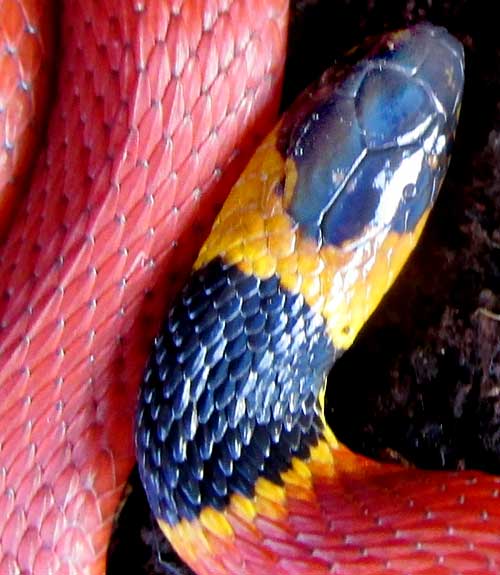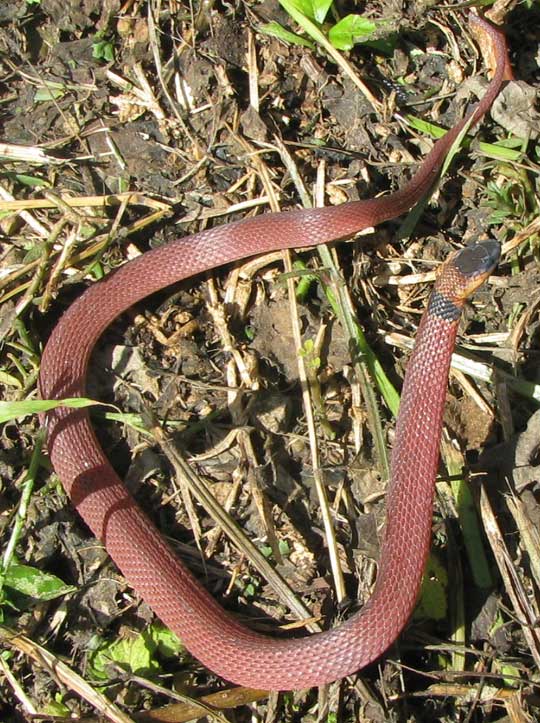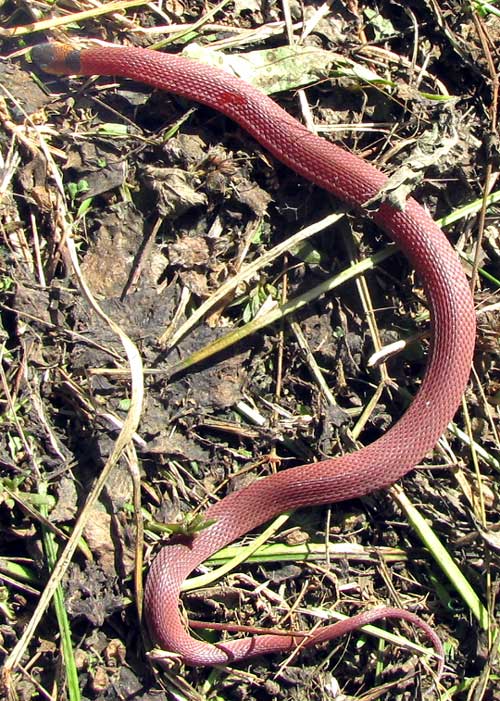Excerpts from Jim Conrad's
Naturalist Newsletter
from the April 30, 2017 Newsletter issued from Rancho Regensis north of Valladolid, Yucatán, MÉXICO;
elevation ~40m (~130 ft), N~20.876°, W~88.170°
RED COFFEE-SNAKE
One morning this week in the garden I lifted up a sheet of cardboard mulch and found the little foot-long snake shown below:

A close-up of the head highlighting the species' distinctive scale pattern, as well as offering a study of its beautiful coloring, is shown below:

supplement info for picture sent in 2007 from central Yucatán State, MEXICO
RED COFFEE-SNAKE
 Workers on the property of Elvira Jimenez near Ek Balam north of Valladolid, Yucatan ran into several Red Coffee-Snakes, Ninia sebae, of which one is pictured at the right. Of course the workers assured Elvira that they were deadly poisonous, and killed them all.
Workers on the property of Elvira Jimenez near Ek Balam north of Valladolid, Yucatan ran into several Red Coffee-Snakes, Ninia sebae, of which one is pictured at the right. Of course the workers assured Elvira that they were deadly poisonous, and killed them all.
These are wonderful, perfectly harmless little snakes who feed mostly on earthworms, slugs and land snails. They make a half-hearted attempt at mimicking the venomous coral snake, but that species has broad bands of red, yellow and black. Note how this individual is flattening his front part to make himself look more threatening. It's all bluff. Please don't kill this snake.
This is a commonly encountered species, in Spanish often known as Basurera, which means "hanging about in the rubbish." It's also known as dormilona, or "sleeper," because sometimes when he knows he's been discovered he holds still, on the theory that you might overlook him.
The species occurs from Veracruz and Oaxaca through Central America to Costa Rica. Having such a large distribution, its appearance displays wide geographic variation. Some individuals have no black markings on the top while others are black-spotted on the front two-thirds of their bodies. At least in Guatemala sometimes distinctive black crossbands across the top are narrowly edged with yellow.
from the November 29, 2009 Newsletter issued from Hacienda Chichen Resort beside Chichén Itzá Ruins, central Yucatán, MÉXICO; limestone bedrock, elevation ~39m (~128ft), ~N20.676°, ~W88.569°
A FAINTING, GARBAGE-LOVING SNAKE
Paulino told me he'd come upon a coral snake while macheteing around the compost heap and had the snake in a bottle in case I wanted to see it. The snake was about a foot long and red except for a black head and a black band behind the neck. I didn't think it was a coral, but I wasn't sure enough to venture emptying the bottle into my hand, for coral snakes are very venomous.
The problem is that the coral snake we have here isn't the Eastern Coral Snake with its distinctive red, yellow and black banding but rather the Variable Coral Snake which, as the name suggests, is very variable. Add in undeveloped patterns of immature individuals -- and Paulino's snake was small enough to be a young one -- and geographic variation, and IDing gets hard. I dumped the snake onto the ground and took the picture below:

The snake raised its head and somewhat flattened his upper part. This didn't seem like coral snake behavior at all, but it did remind me of some neck-spreading exhibited by a snake in a picture sent to me some time ago by a reader down here. You can see that picture at the top of this page.
I tried maneuvering the snake into a more photogenic setting, but instead of moving he did what's shown below:

The poor thing just keeled over, his head lying sidewise on the ground, and no amount of nudging would stir him! I'd have thought I had a snake suffering a heart attack, but I'd read that the spread-headed snake in the first picture above does this very thing -- plays dead when its vicious-looking head-spreading doesn't frighten away predators. Now I knew that I had that same snake. It was the Red Coffee-Snake NINIA SEBAE, a perfectly harmless little being who couldn't hurt you if he tried.
One Spanish name for this snake is "Basurera Roja," or "Red Garbage-Dump Snake," because it's so often found in garbage dumps. Another name is "Dormilona," or "Sleeper," because of the "fainting" behavior shown above.
This little snake does a great job scaring people and other animals who know how dangerous coral snakes are. But in this world with lots of machete-wielding men, its pseudo-coral coloration, patterning and threatening head-spreading behavior, most who get caught are cut to pieces.